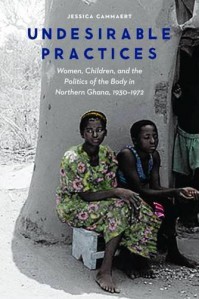

Undesirable Practices: Women, Children, and the Politics of the Body in Northern Ghana, 1930–1972
by Jessica Cammaert
The politics of women's rights is a complex subject, and that's without adding relativism, imperialism, and cultural trusteeship to the mix. Undesirable Practices seeks to track the relationships and reactions to nudity, FGM (referred to in the book as "female circumcision"), and slavery-related practices such as human pawning. Some of the facts are as startling as they are appalling; for example, for years, colonists actively encouraged FGM of infants under the apparent belief that it was milder than when performed on adolescents.
Cammaert tackles a dense subject, and as an utter novice in the subject, I soon discovered that I was not in the book's target audience. Thesis-turned-nonfiction-type books vary widely in their levels of accessibility. Cammaert assumes a high level of expertise in her readers, or at least a higher level than I could muster. She casually refers to events such as the 1922 Women's War in southeastern Nigeria and the politics of the Gold Coast with the assumption that the reader will catch the references without further explanation. Personally, I spent a lot of time on Wikipedia. The book seeks to fill in the anthropological side of the issue and therefore doesn't discuss the statistics, apparently assuming the reader already is familiar with them. As a numbers person, I was left adrift in a sea of assertions with plenty of anecdotes but precious little proof. For example, Cammaert portrays "bundo," or "female circumcision," as an operation performed by men on women. This is the antithesis of everything I've ever heard about bundo, and given that her primary proof seemed to be a single event observation by a male anthropologist in the 1930s, I remained unconvinced.
Undesirable Practices would, I think, be a fascinating book for an expert in the subject, someone already aware of the history of the area, the underlying statistics, and the impact of trusteeship, FGM, and pawning on the affected cultures. The book is, in some ways, mainly about the anthropologists, not about the people they studied or even the repercussions of those studies on the people. In particular, it focuses heavily on anthropologist Robert Sutherland Rattray and in particular, the tensions between Rattray and the colonial authorities.
Starting with the colonists' attempts to recreate a mythical pre-colonial Africa, it tracks the ways that male colonial bias, fear of detribalization, and a preference for indirect rule--but not cultural relativism-- led to the trustees' support of initiation rights even as a changing economy exacerbated practices such as pawning. Reaction to this fostered the creation of rescue narratives which in turn led to a backlash against "primitive" practices such as nudity. Possibly due to my lack of knowledge, I found the narrative somewhat disconnected. In fact, until she restated it in the conclusion, I couldn't have told you precisely what Cammaert's thesis was. While I was thoroughly convinced by her argument that women were seen primarily in reproductive terms and that cultural upheaval was repeatedly framed in terms of "gender chaos," I was less persuaded by her argument that these issues were driven by male power over women, with men exercising their power by dismissing the problem and instead "looking away." While that element is certainly present, casting an embarrassed unwillingness to delve into "women's matters" as a cool exercise of male trusteeship. It seemed more like bewildered incompetence to me.
However, many other aspects of the narrative were fascinating, such as the colonial legal case surrounding the pawning/enslavement of three girls. It was fascinating to hear the narrative from the girls themselves, even if it was refracted through the eyes of the colonial authorities. I was also interested by the sharp distinction made between FGM and male circumcision. During most of the relevant time period, the (minimal and still-disputed) health benefits of male circumcision were unknown, meaning that the primary difference came from whether the mutilation was performed by the colonials as well. The most interesting aspect of the narrative came after the nation gained independence and began to struggle with "undesirable practices" as a way of shedding perceived primitivism. Suddenly, nudity had become a woman's problem, and in turn was cast as a problem for the whole country. Overall, while it assumes a high degree of familiarity with the subject, if you already know the cultural and historical context, I think Undesirable Practices would make for an interesting read.
~~I received an advanced reader copy of this ebook through Netgalley from the publisher, University of Nebraska Press, in exchange for my honest review.~~

 3
3




